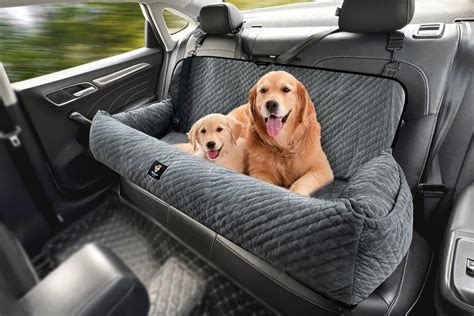Introduction
Dog car beds have become an increasingly popular accessory for pet owners, providing their furry companions with a comfortable and secure place to rest while traveling. However, the environmental impact of these products has recently come under scrutiny. This article explores the environmental impact of dog car beds, comparing different materials and manufacturing processes, and provides tips for eco-conscious consumers.

Understanding the Environmental Footprint
The production and disposal of dog car beds can contribute to environmental issues such as:
- Greenhouse Gas Emissions: Manufacturing materials (e.g., plastics, foam) and transporting the beds can release greenhouse gases into the atmosphere.
- Resource Depletion: The use of non-renewable resources, such as petroleum-based plastics, can contribute to the depletion of Earth’s natural resources.
- Waste Generation: Discarded dog car beds can end up in landfills, taking up space and potentially leaching harmful chemicals into the environment.
Materials and Their Environmental Impact
The choice of materials used in dog car bed production has a significant impact on its environmental footprint:
1. Conventional Materials:
- Plastic: Common in low-cost beds, plastic is non-biodegradable and its production and disposal can release toxic chemicals.
- Foam: Typically polyurethane foam, which is made from petroleum and can release harmful chemicals during manufacture and decomposition.
2. Eco-Friendly Materials:
- Natural Fibers: Materials like cotton, hemp, and bamboo are biodegradable and renewable, reducing the use of fossil fuels.
- Recyclable Materials: Recycled polyester and plastic can be used to create beds that reduce waste and conserve resources.
- Biodegradable Materials: Beds made from materials like shredded paper or cardboard are compostable and can break down naturally.
Sustainable Manufacturing Practices
Beyond material selection, sustainable manufacturing practices can further reduce the environmental impact of dog car beds:
- Energy Efficiency: Using energy-efficient processes and renewable energy sources in production can lower the carbon footprint.
- Waste Reduction: Implementing measures to minimize waste generation, such as recycling by-products and reducing packaging, can conserve resources.
- Ethical Labor Practices: Ensuring fair wages and safe working conditions for employees supports sustainable business practices.
Eco-Conscious Tips for Consumers
Pet owners can make informed choices to minimize the environmental impact of dog car beds:
- Choose Eco-Friendly Materials: Opt for beds made from natural fibers, recycled materials, or biodegradable materials.
- Support Sustainable Brands: Look for companies that prioritize sustainability in their production processes and supply chains.
- Consider Repurposing or Donating: Instead of discarding old beds, consider repurposing them or donating them to animal shelters or rescue organizations.
Current Status and Future Outlook
As consumer awareness of environmental issues grows, the demand for sustainable dog car beds is increasing. Many manufacturers are investing in eco-friendly materials and practices to meet this demand. The future holds promise for the development of innovative sustainable materials and technologies that further reduce the environmental impact of these products.
Conclusion
Dog car beds provide convenience for pet owners and comfort for our furry friends, but it is crucial to consider their environmental impact. By understanding the materials and manufacturing practices involved, and making informed choices, consumers can support eco-conscious businesses and reduce the environmental footprint of their pet’s travel accessories.
Table 1: Comparison of Materials for Dog Car Beds
| Material | Environmental Impact |
|---|---|
| Plastic | Non-biodegradable, releases toxic chemicals |
| Foam | Made from petroleum, releases harmful chemicals |
| Natural Fibers | Biodegradable, renewable |
| Recycled Materials | Reduces waste, conserves resources |
| Biodegradable Materials | Compostable, breaks down naturally |
Table 2: Environmental Impact of Manufacturing Practices
| Practice | Impact |
|---|---|
| Energy Efficiency | Reduces carbon footprint |
| Waste Reduction | Conserves resources |
| Ethical Labor Practices | Supports sustainability |
Table 3: Eco-Conscious Tips for Consumers
| Tip | Impact |
|---|---|
| Choose Eco-Friendly Materials | Reduces environmental impact |
| Support Sustainable Brands | Promotes ethical practices |
| Consider Repurposing or Donating | Reduces waste |
Table 4: Future Trends in Sustainable Dog Car Beds
| Trend | Benefits |
|---|---|
| Innovative Materials | Reduced environmental impact |
| Biodegradable Technologies | Enhanced compostability |
| Sustainable Supply Chains | Reduced carbon footprint |





















